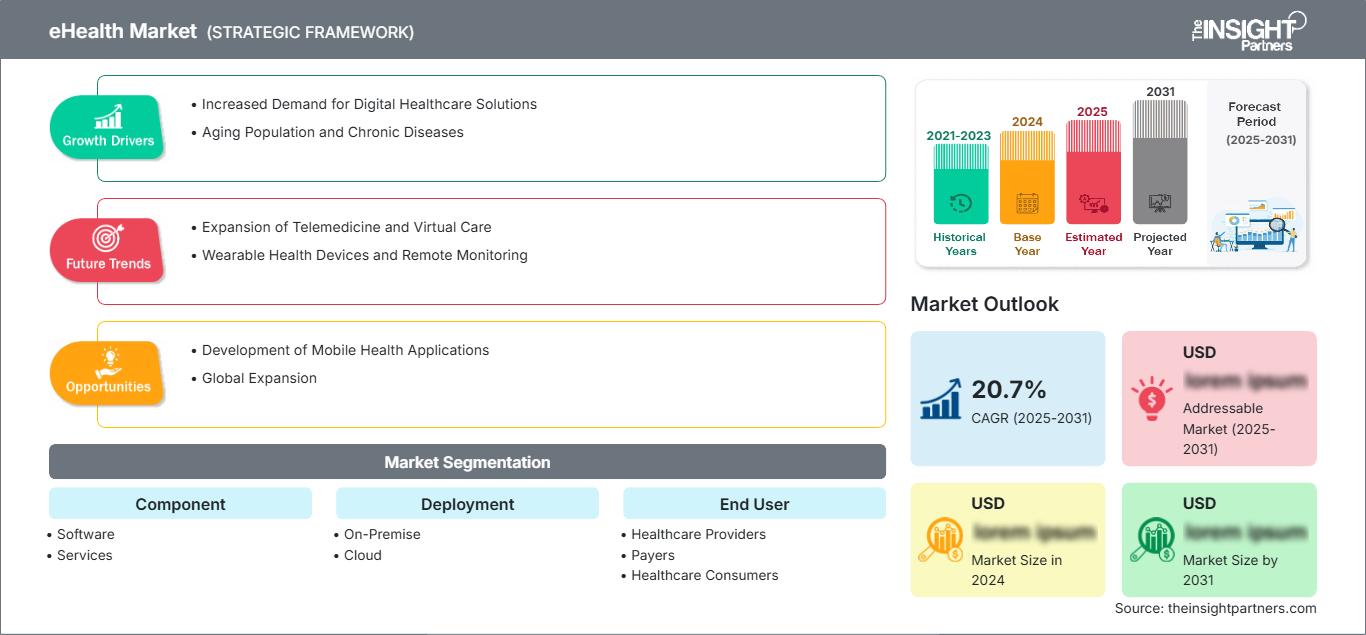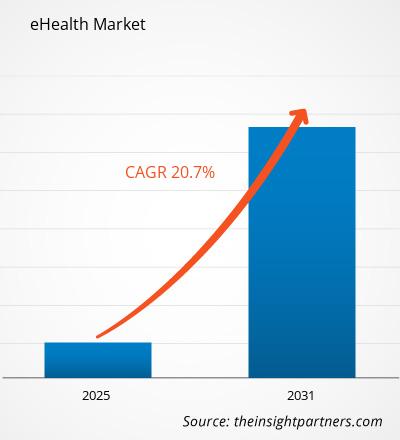Si prevede che il mercato dell'eHealth registrerà un CAGR del 20,7% dal 2025 al 2031, con una dimensione del mercato in espansione da XX milioni di dollari nel 2024 a XX milioni di dollari entro il 2031.
Il rapporto è segmentato per componente {Software (Cartelle Cliniche Elettroniche, Prescrizione Elettronica, Sistemi di Supporto alle Decisioni Cliniche, Telemedicina e Altri Componenti), Servizi}; Distribuzione (On-Premise, Cloud), Utente Finale (Fornitori di Servizi Sanitari, Pagatori, Consumatori di Servizi Sanitari e Altri). L'analisi globale è ulteriormente suddivisa a livello regionale e per i principali Paesi. Il rapporto offre il valore in USD per l'analisi e i segmenti sopra indicati.
Scopo del rapporto
Il rapporto eHealth Market di The Insight Partners mira a descrivere il panorama attuale e la crescita futura, i principali fattori trainanti, le sfide e le opportunità. Ciò fornirà spunti a vari stakeholder aziendali, come:
- Fornitori/produttori di tecnologia: per comprendere le dinamiche di mercato in evoluzione e conoscere le potenziali opportunità di crescita, consentendo loro di prendere decisioni strategiche informate.
- Investitori: per condurre un'analisi completa delle tendenze in merito al tasso di crescita del mercato, alle proiezioni finanziarie del mercato e alle opportunità esistenti lungo la catena del valore.
- Organismi di regolamentazione: per regolamentare le politiche e le attività di controllo nel mercato con l'obiettivo di ridurre al minimo gli abusi, preservare la fiducia degli investitori e sostenere l'integrità e la stabilità del mercato.
Componente di segmentazione del mercato eHealth
- Software
- Servizi
Distribuzione
- On-Premise
- Cloud
Utente finale
- Fornitori di servizi sanitari
- Pagatori
- Consumatori di servizi sanitari
Geografia
- Nord America
- Europa
- Asia Pacifico
- Medio Oriente e Africa
- America meridionale e centrale
Potrai personalizzare gratuitamente qualsiasi rapporto, comprese parti di questo rapporto, o analisi a livello di paese, pacchetto dati Excel, oltre a usufruire di grandi offerte e sconti per start-up e università
Mercato della sanità elettronica: Approfondimenti strategici

- Ottieni le principali tendenze chiave del mercato di questo rapporto.Questo campione GRATUITO includerà l'analisi dei dati, che vanno dalle tendenze di mercato alle stime e alle previsioni.
Fattori di crescita del mercato dell'eHealth
- Aumento della domanda di soluzioni sanitarie digitali: la domanda di soluzioni sanitarie digitali è aumentata perché l'assistenza sanitaria è diventata più incentrata sul paziente e basata sui dati. Le tecnologie eHealth sono sempre più adottate nei paesi come mezzo per migliorare l'esperienza del paziente.
- Invecchiamento della popolazione e malattie croniche: con l'aumento dell'aspettativa di vita globale, molti anziani soffrono di malattie croniche. Questo cambiamento demografico richiede soluzioni sanitarie più efficienti, che l'eHealth può fornire.
Tendenze future del mercato dell'eHealth
- Espansione della telemedicina e dell'assistenza virtuale: l'adozione di servizi di telemedicina e assistenza sanitaria virtuale è destinata a crescere in modo significativo, trainata dai progressi nelle tecnologie di comunicazione digitale e dalla crescente domanda di un'assistenza sanitaria comoda e accessibile. In futuro, le piattaforme di telemedicina saranno maggiormente integrate con altre soluzioni di eHealth, consentendo consulenze senza interruzioni, monitoraggio remoto e accesso a operatori sanitari di diverse specialità. Chatbot basati sull'intelligenza artificiale, diagnosi remota e assistenti sanitari virtuali miglioreranno ulteriormente l'esperienza dei pazienti, fornendo un'assistenza personalizzata e riducendo al contempo il carico sui sistemi sanitari tradizionali. La telemedicina si espanderà anche ai servizi di salute mentale, alla riabilitazione e alla gestione delle malattie croniche, consentendo a un numero sempre maggiore di persone di accedere all'assistenza sanitaria comodamente da casa. Dispositivi sanitari indossabili e monitoraggio remoto: l'uso di dispositivi indossabili e strumenti di monitoraggio remoto continuerà ad aumentare, consentendo il monitoraggio continuo di parametri sanitari vitali come frequenza cardiaca, pressione sanguigna, livelli di glucosio e ritmi del sonno. Questi dispositivi saranno sempre più integrati con piattaforme basate su cloud, consentendo agli operatori sanitari di monitorare da remoto i dati dei pazienti in tempo reale e di intervenire quando necessario.
Opportunità di mercato dell'eHealth
- Sviluppo di applicazioni sanitarie mobili: il segmento delle app mediche è uno dei maggiori contributori al mercato dell'eHealth, il che indica un'importante opportunità per gli sviluppatori di creare applicazioni innovative per la gestione della salute.
- Espansione globale: poiché sempre più paesi riconoscono i vantaggi dell'eHealth, si aprono grandi opportunità di espansione del mercato, in particolare nelle regioni in via di sviluppo in cui l'accesso all'assistenza sanitaria è limitato.
Approfondimenti regionali sul mercato dell'eHealth
Le tendenze regionali e i fattori che influenzano il mercato dell'eHealth durante il periodo di previsione sono stati ampiamente spiegati dagli analisti di The Insight Partners. Questa sezione analizza anche i segmenti e la geografia del mercato dell'eHealth in Nord America, Europa, Asia-Pacifico, Medio Oriente e Africa, America Meridionale e Centrale.
Ambito del rapporto sul mercato dell'eHealth
| Attributo del rapporto | Dettagli |
|---|---|
| Dimensioni del mercato in 2024 | US$ XX million |
| Dimensioni del mercato per 2031 | US$ XX Million |
| CAGR globale (2025 - 2031) | 20.7% |
| Dati storici | 2021-2023 |
| Periodo di previsione | 2025-2031 |
| Segmenti coperti |
By Componente
|
| Regioni e paesi coperti | Nord America
|
| Leader di mercato e profili aziendali chiave |
|
Densità degli operatori del mercato dell'eHealth: comprendere il suo impatto sulle dinamiche aziendali
Il mercato dell'eHealth è in rapida crescita, trainato dalla crescente domanda degli utenti finali, dovuta a fattori quali l'evoluzione delle preferenze dei consumatori, i progressi tecnologici e una maggiore consapevolezza dei benefici del prodotto. Con l'aumento della domanda, le aziende stanno ampliando la propria offerta, innovando per soddisfare le esigenze dei consumatori e sfruttando le tendenze emergenti, alimentando ulteriormente la crescita del mercato.

- Ottieni il Mercato della sanità elettronica Panoramica dei principali attori chiave
Punti di forza
- Copertura completa: il rapporto analizza in modo esaustivo prodotti, servizi, tipologie e utenti finali del mercato dell'eHealth, offrendo una panoramica olistica.
- Analisi degli esperti: il rapporto è redatto sulla base della conoscenza approfondita di esperti e analisti del settore.
- Informazioni aggiornate: il rapporto garantisce la pertinenza aziendale grazie alla copertura di informazioni e tendenze dei dati più recenti.
- Opzioni di personalizzazione: questo rapporto può essere personalizzato per soddisfare le esigenze specifiche del cliente e adattarsi in modo appropriato alle strategie aziendali.
Il rapporto di ricerca sul mercato dell'eHealth può quindi contribuire a guidare il percorso di decodificazione e comprensione dello scenario del settore e delle prospettive di crescita. Sebbene possano esserci alcune valide preoccupazioni, i vantaggi complessivi di questo rapporto tendono a superare gli svantaggi.
- Analisi storica (2 anni), anno base, previsione (7 anni) con CAGR
- Analisi PEST e SWOT
- Valore/volume delle dimensioni del mercato - Globale, Regionale, Nazionale
- Industria e panorama competitivo
- Set di dati Excel
Report recenti
Testimonianze
Motivo dell'acquisto
- Processo decisionale informato
- Comprensione delle dinamiche di mercato
- Analisi competitiva
- Analisi dei clienti
- Previsioni di mercato
- Mitigazione del rischio
- Pianificazione strategica
- Giustificazione degli investimenti
- Identificazione dei mercati emergenti
- Miglioramento delle strategie di marketing
- Aumento dell'efficienza operativa
- Allineamento alle tendenze normative




















 Ottieni un campione gratuito per - Mercato della sanità elettronica
Ottieni un campione gratuito per - Mercato della sanità elettronica